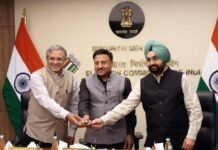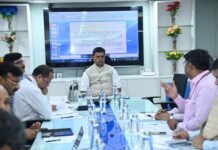Chandigarhi, 29th August 2018: In an attempt to address widespread micronutrient deficiencies such as anaemia, the Food Safety and Standards Authority of India (FSSAI), took a step ahead by boosting efforts towards large-scale fortification of food in Haryana, Punjab and Chandigarh. The first-evermedia workshop was organized in Chandigarh to engage and sensitize the local media about the importance of food fortification.Otherhealth and nutrition related interventions such as importance of nutrition during the first 1000 days of life, reducing the consumption of foods high in salt, sugar and fat, and food safety were also covered. Since the majority of people are unaware of food fortification and its health benefits, this workshop served as a stepping-stoneto bridge this knowledge gap.
As per NHFS – IV, almost 76 percent of the female population in the city of Chandigarh suffer from anaemia – the second highest amongst all states and UTs.Prevalence of anaemia in children (age 6 to 59 months) at 73 percent is the highest in Chandigarh amongst all Northern States as well. Food fortification is a complementary strategy to fight micronutrient deficiencies such as anaemia,which is also simple, sustainable, safe and cost-effective.Food fortification is the addition of key vitamins and minerals such as iron, iodine, Vitamin A and D etc. to staple foods such as wheat flour, rice, vegetable oil, milk and salt to improve their nutritional content. However, the majority of people are unaware of food fortification and its health benefits and it remains shrouded in myths and doubts.
The workshop clarified key issues surrounding food fortification. Standards for fortified foods have been gazette notified asof 2nd August, 2018for wheat flour, maida and rice (with Iron, Folic Acid and Vitamin B 12), Milk and edible vegetable oil (with Vitamin A and D) and Double Fortified Salt (with Iodine and Iron). These standards have been created after careful deliberations of the scientific panel on nutrition and fortification, constituted with public health experts keeping in mind the balance between health benefits and toxicity levels of the added micronutrients. The standards provide a range of the dosage, which aims at providing 30-50 percent of the daily recommended dietary allowance (RDA) of the nutrients. The dosage of the premix used in the fortified staples is within safe limits and the focus is on ensuring the safety of the fortified food products rather than the source of the premix.
Chandigarh has voluntarily started rice fortification through its ICDS and MDM programmes, which caters to approximately one lakh beneficiaries. Haryana has introduced fortified wheat flour in its ICDS and PDS programmes as well as fortified vegetable oil in ICDS, MDM and PDS, voluntarily.Punjab is also geared up to introduce fortified foods in its safety net programmes. A +F logo has been notified to identify fortified staples in the open market and their availability is gaining traction. At present, food fortification is voluntary and it is akin to a three-legged race in which fortification needs to be scaled up step-by-step before it becomes mandatory.
On 10th July, FSSAI kick-started a nation-wide public awareness campaign called ‘Eat Right India’ to usher in a ‘new food culture’ with the right food and dietary choices among citizens. The movement is a collective effort of the FSSAI, the health department, local Government bodies and development partners to nudge and empower citizens to improve their health and wellbeing. The movement includes eating safe, eating healthy, encouraging the consumption of fortified foods and lowering that of foods high in fat, salt, and sugar.The workshop was followed by the state launch of the ‘Eat Right India’ Movement in Chandigarh.A six-month media partnership program, a joint effort of FSSAI, the World Bank and HEAL Foundation, to build sustained awareness among citizens on eating right through the local media was also launched on the occasion.
Key officials from the States of Punjab, Haryana and Chandigarh UT participated at the launch event to support the ‘Eat Right India’Movement. They included Sh. K S Pannu, Secretary – Agriculture and commissioner of food safety, Agriculture Department, Govt. of Punjab and Sh. B. L. Sharma, Secretary – Education, Social Welfare, Women & Child Development, Chandigarh. Public health professionals, nutritionists, the medical community, professors from universities/colleges, executive chefs and other local bodies also came together through this common platform to lend their support to this ‘movement’.
Speaking on the occasion, Sh. Pawan Agarwal, CEO FSSAI said, “Chandigarh, like the rest of the country, is fighting a dual burden of malnutrition. Such figures, by no means, serve any justice to the city titled ‘The City Beautiful’. Hence, FSSAI has selected Chandigarh to be the first city to launch the ‘Eat Right Movement’ and to take lead in food fortification related activities. We hope this will lead to social and behavioural change among citizens.”
Speaking at the launch, Sh. B. L. Sharmahighlighted that “the Global Nutrition Report 2017 found 38% of children under 5 years of age stunted and 21% wasted, 51% women of reproductive age were anemic and 22% of adult women are overweight. Opting for fortified food, ensuring safety of food and consciously reducing intake of food with high sugar, salt and fat are simple ways to improve individual and societal nutrition status.”
Citing ICMR’s 2017 report titled – India: Health of Nation’s States, Dr. G Dewan, Director of Health Services and Mission Direction, National Health Mission mentioned that “From 1990 to 2016, burden of diabetes in India has increased manifold. Heart diseases are among the top 10 leading causes of deaths in Punjab and Haryana. The ‘Eat Right India Movement’ sends a very relevant message that the simple act of reducing fat, salt and sugar in our daily diet can make a strong and positive difference in our health status.”
Emphasizing on importance of nutrition in first 1000 days, AshiKathuria, Senior Nutritionist from World Bank, added“Nutrition in the early years of life, including the period when the child is in the mother’s womb has lifelong impact. Recent evidence indicates that adequate nutrition, early learning and stimulation are critical for children to achieve their full human potential in adulthood. Children who receive these in time and in sufficient measure, show better educational attainment, higher incomes and contributions to economic growth.”








